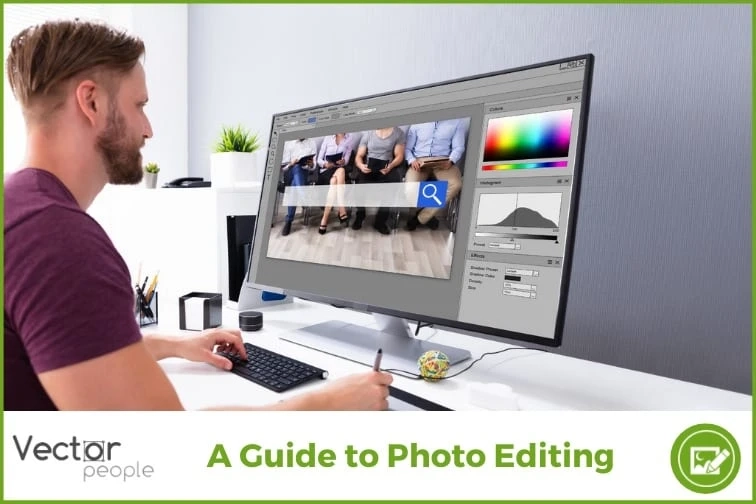The photoshoot is over, but the job is not. You will need to edit your photos to look their best. Editing photos can seem daunting, but it can be easy with the right tools and a little practice!
There are many different ways to edit photos. Some people prefer to use professional software like Adobe Photoshop, while others prefer simpler apps like Snapseed. No matter your chosen method, the goal is to make your photos look their best!
If you want to learn more about post-production and how it may help you grow your business, this guide is for you! We will cover the basics of photo editing, including how to crop, resize, and adjust the color and contrast of your photos and restoration!
So let\'s get started!
What is Photo Editing?
The process of altering a photograph is referred to as image editing. But, that is to oversimplify a topic that may be complex and utilizes several approaches and techniques.
For example, some photo editing software programs will allow you to make global changes to your image. It might include lightening or darkening the entire photo, increasing or decreasing the contrast, or changing the color balance.
Other software programs might focus on localized changes, allowing you to change specific image areas. It might include removing blemishes or wrinkles, whitening teeth, or changing the color of someone\'s clothing.
Depending on your software, there are also many different ways to edit photos. Some photo editing software programs are designed for general users, while others are geared toward professional photographers.
The following are some additional names for picture editing:
- Image editing
- Photo retouching
- Image enhancement
- Digital image processing
- Post-processing
- Image/photo manipulation
- Photoshopping
The Importance of Image Editing
Editing helps you take an average photo and turn it into a great one. As a result, niche photographers may develop and emphasize their style. Editing is also helpful for branding in businesses.
For e-commerce firms, image editing is essential. The quality of the image is the first selling point for any product. It affects the customer\'s buying decision.
Many studies have shown that high-quality pictures outperform stock photos and that increasing the number of high-quality images helps consumers trust you and boost conversion rates. With the help of photo editing services, you can take an average photo and turn it into a great one that will leave a lasting impression on your customers.
What are the Various Types of Photo Editing?
There are a variety of procedures for editing photos, some of which are simple and others quite complicated.
Most people can perform basic picture editing on their own—though this takes time and patience. But, a professional editor or a specialized software program may need more intricate modifications.
Simple Photo-Editing Tricks
Here are some simple photo-editing methods you might try:
- Straighten: This is one of the most basic edits you can make. If your photo is crooked, you can fix it using the "straighten" tool. It aids in the change of the photo\'s horizon.
- Crop: Cropping is a way to remove the background or unwanted parts of the photo and focus on the main subject.
- Resize: You might need to resize your photo if it\'s too large or small for the required space. For example, if you\'re posting a photo on social media, you\'ll need to resize it to fit the site\'s dimensions.
- Sharpen: If your photo looks blurry, you can use the "sharpen" tool to make it clearer.
- Noise Reduction: It smoothes the picture and removes the digital artifacts.
- Colour Correction: This is used to fix the white balance and tint.
- White Balance: The white balance is used to adjust the colors in a photo to look more natural.
- Contrast: Contrast is used to make the colors in a photo more or less saturated.
- Exposure: Exposure is used to lighten or darken a photo.
- Lens Correction: Lens correction is used to fix the distortion caused by a camera\'s lens.
- Color adjustments: These include Hue, Saturation, and Luminance. They are used to change the colors in a photo.
- Background removal: This is used to remove the background from a photo to make the subject more visible.
Complex Techniques
The following are some more complex photo-editing techniques:
- Clipping paths: Clipping paths remove the background from a photo to make the subject more visible.
- Portrait corrections: Portrait corrections are used to improve a person\'s appearance in a photo.
- Drop and reflection shadow: Drop and reflection shadows are used to create a realistic shadow effect.
- Special effects: Special effects can create a unique look for your photos, like adding animation, changing colors, or adding textures.
- Adjusting text and visuals: This is used to add or remove text from a photo, as well as to change the size, color, and font of the text.
- Photo stitching: Photo stitching is used to stitch together many photos to create a panorama or collage.
- Photo masking and layers: Photo masking and layers are used to create a more complex image by combining many photos.
Pixel Editing and Parametric Image Editing
Pixel editing and parametric image editing are two types of digital photo alteration. Let\'s look at what they mean:
What Exactly is Pixel Editing?
Pixel editing, sometimes called pixel-level editing, is the process of changing an image at a pixel level. Because you\'re modifying the pixels, this also alters the image file. That is why pixel editing is considered a detrimental sort of picture editing since it\'s difficult to reverse the changes and restore the original file. With photo editing services, old image restoration is possible that your thoughts were lost.
Pixel editing makes it possible to perform intricate modifications. And execute tasks that parametric image editing can\'t, such as CMYK color modes.
What is Parametric Image Editing?
The pixels of an image are not modified by parametric image editing (PIE). Instead, they are recorded as instructions for achieving the final appearance. It\'s a non-destructive way to change photos. PIE, but it does not always allow for all sorts of modifications. The most common use of parametric image editing is in RAW processing, where the user changes things like exposure, white balance, etc., without altering the image file.
Many professionals advocate starting with PIE and enhancing the final details with pixel editing. This workflow gives you the best of both worlds: the ability to make global changes without damaging the image quality and the ability to fine-tune the details with pixel-level control.
Editing Product Photos
Post-production may be required for almost all product photos. One of the essential things to consider is consistency, especially if you\'re working on several items for the same firm or providing many images of the same item.
A picture is worth a thousand words. It\'s true that photos help market businesses and sell items, but where will the image be used? Is it for advertising, an e-commerce site, social media, or a printed catalog? For example, the differences between a Facebook ad image and a white background photo are significant. Most likely, you\'ll be able to get more creative with ad images. But if you\'re selling on Amazon, Walmart, or other online marketplaces, conforming to their product image requirements is essential.
Here are some of the most frequent types of product photography modifications:
- Brightness and exposure: The brightness and exposure of an image can be increased or decreased to make the product more visible. If you didn\'t get the lighting right, you might make significant changes to your photos after the shoot.
- Background removal: The background of an image can be removed or changed to highlight the product better. It is a common post-production task for e-commerce product photos.
- Colour correction: The colors in an image can be enhanced or changed completely. It is often done to make the product\'s colors more accurate or vibrant. Unfortunately, as many as 64 percent of returns occur because the product does not meet customer expectations based on pictures and descriptions.
- Color change: It\'s critical to exhibit the many colors available for items with various hues. Instead of shooting every product color, photo editors may make modifications after the shoot.
What is a Professional Photo Editor?
An image editor can be a self-employed freelancer, an outsourced service agency, or an employee of a company that edits images. A photo editor might have a variety of job titles, including digital photo editor, graphic designer, or art director.
Photo editors specialize in a specific sector, like photographers. For example, real estate, editorial, and product photography have trends and complexities. Image editors that specialize in e-commerce know how to make things stand out. They understand how to use white space, graphics, and color psychology to increase conversions.
The best photo editors have years of experience. They know the latest trends in their field and how to use photoshop, lightroom, and other software. They also know how to take photos themselves and understand the complexities of photography.
A photo editor is not the same as a retoucher. A retoucher focuses on improving the appearance of an image, while an editor changes the image\'s content.
Photo editors may work with photographers, businesses, or publications. They often have a background in graphic design, art, or photography.
The Bottom Line
It\'s possible to have a lot of fun editing photos, but it is time-consuming and difficult, especially if you\'re starting from scratch. Hiring a professional photo editor is the best way to get great results without all the stress. The experts at Vector People are here to assist you if you need quick, affordable, or high-quality photo editing services.
Vector People is a team of professional photo editors that can help you with any editing need, from simple brightness and color adjustments to complete background removal, photo restoration, and product image retouching. We\'re here to help you make your photos look their best so you can focus on what\'s important - running your business. Contact us today for a free quote.



